From a distance, Francisco Palomares’ fruit cart looks like all the other ones that dot Los Angeles, complete with a multicolored patio umbrella to shield him from the sun.
But step closer.
Instead of a man expertly slicing through mangoes or watermelon, you’ll find an artist leaning before a tiny easel, a brush and palette in his hands. Palomares’ work sells for thousands of dollars in galleries, but on the corner of 3rd Street and Traction Avenue in downtown L.A., he pumps out still lifes for $39.99 a pop.
It’s all part of “Francisco’s Fresh Paintings,” an art installation and mobile gallery/studio through which Palomares aims to disrupt the customary distance between art maker and art buyer, mediated by a dealer. Every 30 minutes, he completes an affordable oil painting, transforming the process of creating and selling art into a type of performance.
The idea for the project, he says, was born out of desperation a few years ago, back when he worked as a gallery attendant at the Museum of Contemporary Art.
Clad from head to toe in black, Palomares would stand in a corner and warn visitors not to get too close to the art. To pass the time, he’d walk up to visitors and ask what they thought about a particular piece. They often scurried away. With time, he grew comfortable with rejection.
Still, he did the job for two years and loved it, he says, “but the pay just wasn’t there.” He was struggling as an artist, and he wasn’t making ends meet. Forgoing an apartment, he would leave work and head back to his Boyle Heights art studio to sleep. Along the way, he would often see vendors selling oranges by the freeway. “Maybe that’s what I need to do to make a sale,” he’d think.
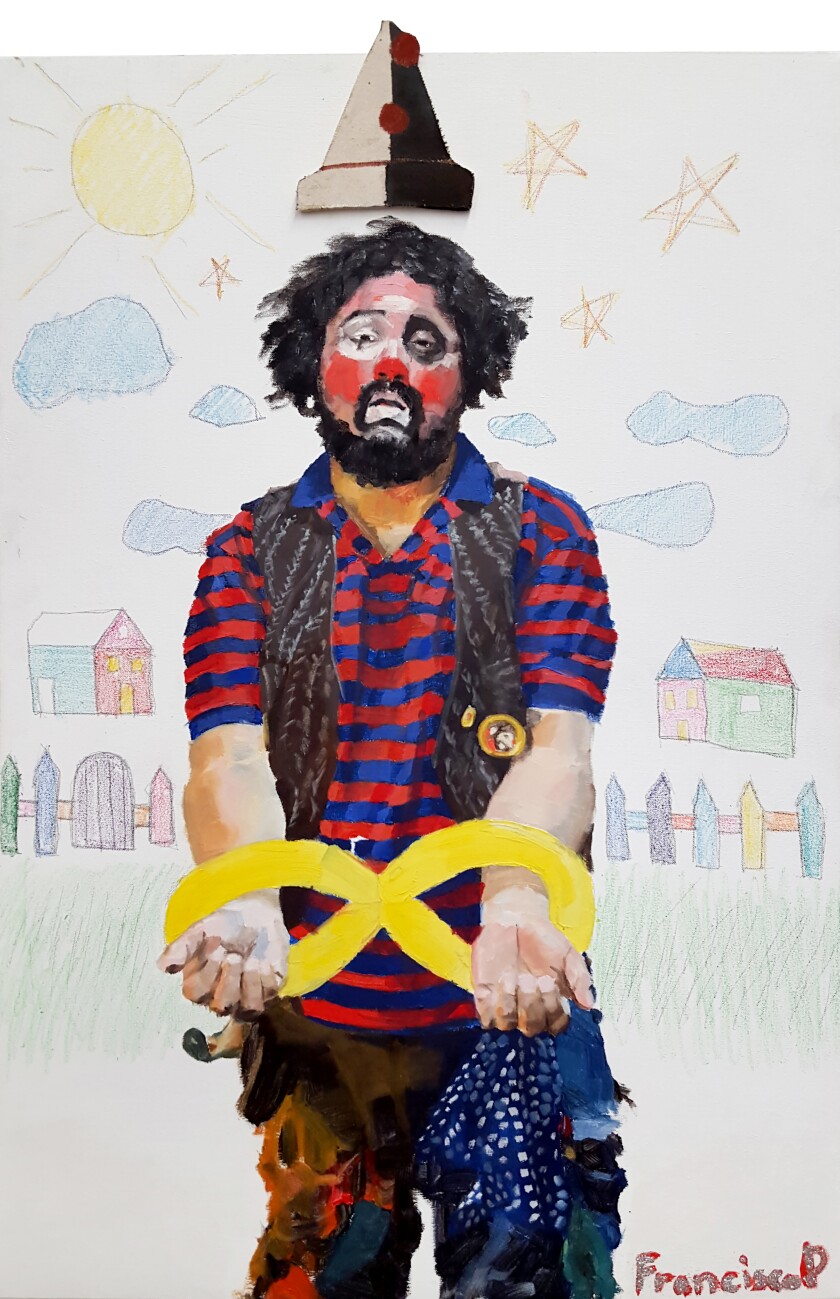
Tired of living paycheck to paycheck, he got a job at a school in South Gate, teaching children about art. Time passed. He had a few shows. Just before the pandemic hit, Palomares traveled to Thailand, thinking he’d come back feeling refreshed. But when he got home, he felt more lost than before.
On the verge of despair, he mentioned the fruit cart idea to friend Ángel Carela.
“What do you need to get started?” Carela asked.
“Well, for one thing, money for the cart,” was Palomares’ answer.
“Go on Craigslist,” Carela said. “Find your cart. I’ll give you the money.”
It was the push he needed.
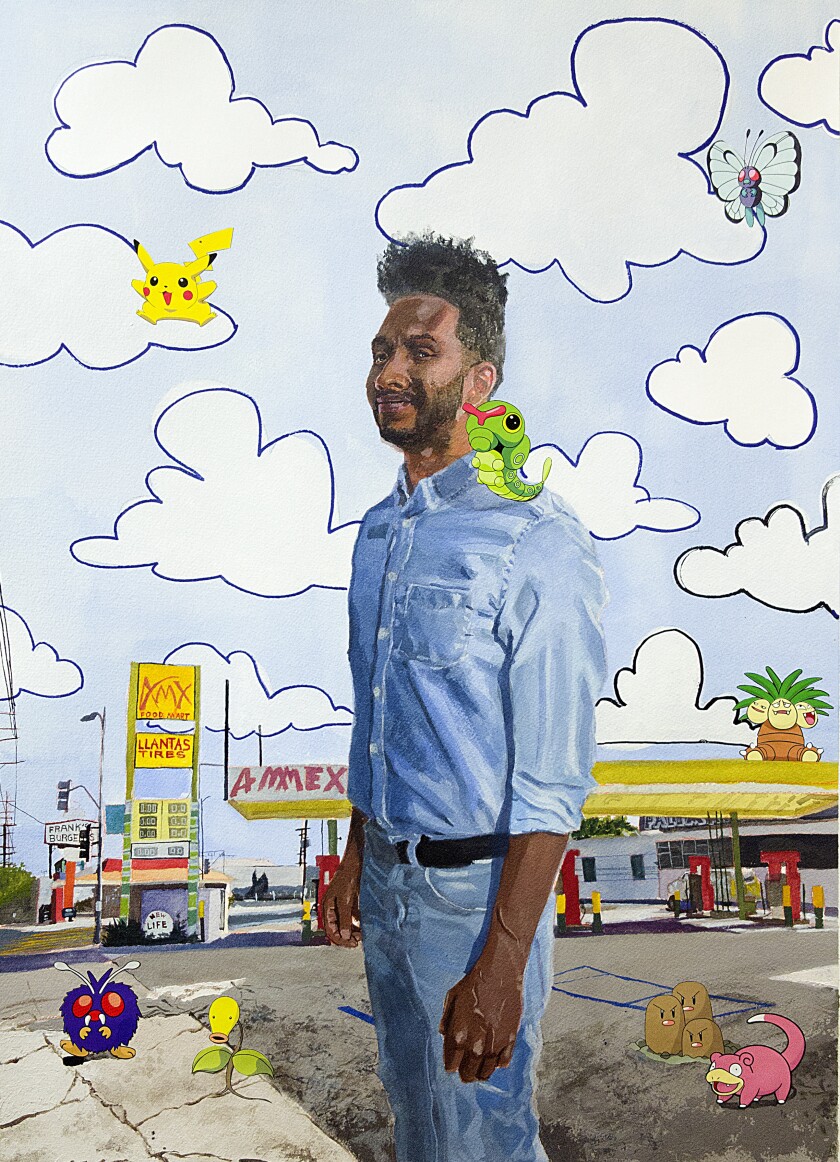
Last summer Palomares began setting up his push cart at Joel Bloom Square in the Arts District. Rents there have skyrocketed, pushing out the residents who gave the district its name. Palomares secured his studio through Art Share L.A., which provides emerging artists with lofts at below-market prices in an effort to preserve the community.
Out on the street, passersby these days timidly pause to take a peek at his cart. When they do, Palomares greets each potential client, inviting them to sift through prints of other work.
“How’s it goin,’ guys?” he says. “Feel free to browse, ask any questions. I have some stuff back here that you’re welcome to check out as well.”
On occasion, non-Latino pedestrians respond to him in Spanish. Palomares, a bilingual Angeleno of Mexican descent, simply goes along.
Last month, for instance, a Florida couple approached him, fumbling a few Spanish phrases before finally giving up.
“Where are you from?” the woman asked.
“Oh, I grew up just across the bridge, in Boyle Heights,” Palomares said.
“Wow!” she said. “That’s the real ’hood.”
Palomares remained gracious throughout the exchange. He didn’t ask the woman what she meant by “real ’hood.” He also didn’t mention that Boyle Heights is embroiled in its own battle with gentrification, or that longtime residents have organized to scare away newcomers — including art goers.
When asked about such interactions, the artist prefers to focus on the positive. Every encounter, he says, is a chance to build rapport. “But sometimes I’ll reflect and I’m, like: What was that conversation? Was that a microaggression?”
He knows that street vendors in Los Angeles have been attacked. Plus, some residents have taken to calling the police on him.
Just a few weeks ago, police approached Palomares’ cart, saying they had received complaints about the volume of his music. They asked for his permits. With Aniceto Molina’s “Cumbia Sampuesana” bubbling in the background, Palomares handed them over.
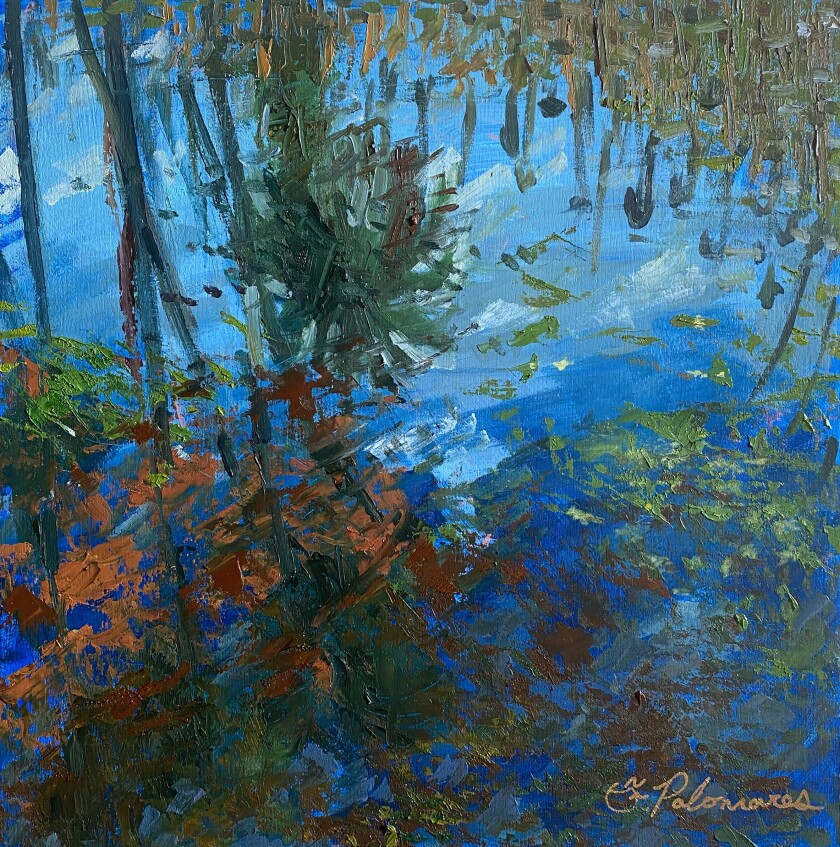
His more extensive works include still lifes, landscapes and portraits. They often feature fellow Angelenos and the places they like to frequent. These include “Echo Park 2020,” which depicts the lake in a style somewhat reminiscent of Claude Monet’s water lilies. “Midnight Hour,” which features a woman sitting inside La Cita, is one of two paintings centered on the beloved downtown bar.
Palomares’ life in art stretches back to third grade, the year he won his first art contest. His teacher gave him some yarn, and he used it to make a silhouette of his dog, Lucy. All around her, he drew cockroaches saying things like: “I gotta go! I’m gonna get swept up!” His prize was a box of markers.
The years that followed included Saturday classes at USC through the nonprofit training program Ryman Arts, along with scholarships to study art in Florence, Italy, and Guangzhou, China, as a Cal State Long Beach student. But it hadn’t been enough.
“I felt trapped,” Palomares says. “I couldn’t imagine doing anything else but I couldn’t figure out how to make it work.”
At Cal State Long Beach, he painted “Brotherhood,” a four-part series that included a portrait titled “René,” based on a bus driver he met. Palomares depicted the man in his work uniform, with a halo around his head.
“I respected him because he took care of his sister,” the artist says. “To me, he’s beautiful. He’s a champ.”
Inspired by the work of Kerry James Marshall, John Valadez and Kehinde Wiley, Palomares continues to portray “everyday Black and brown men with dignity,” often with a divine or regal bearing.
In contrast, Palomares’ representation of women has often consisted of young, thin female nudes. The #MeToo movement has compelled him to think critically about the male gaze in the art world, he says. “After everything that’s come out, you can’t just be painting without having that in mind.”
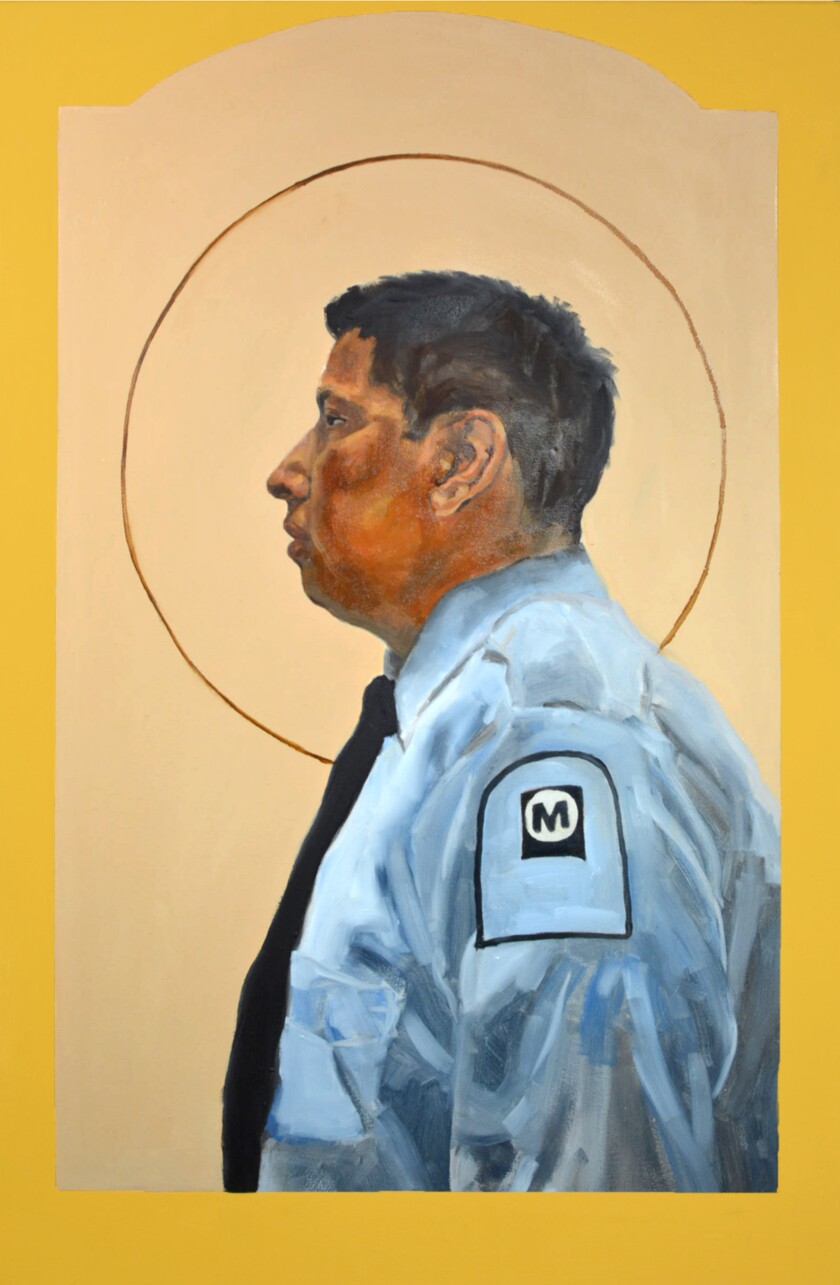
When in need of motivation, Palomares looks to his mother, an immigrant from the Mexican state of Michoacán who founded a housekeeping company in the U.S. and raised him on her own.
“Nobody around me ever says she’s an entrepreneur,” the artist says.
“Maybe it’s because, in the immigrant community, you don’t ‘aspire to start your own business.’ You just need work,” he says. “But that’s a business. And though I’m second generation, I’m part of that.”
Back in his studio, Palomares looks longingly at a painting titled “Agárrate Papá,” which shows a smiling horse piñata looking completely out of place against an earthy background and turbulent sky. He made it in preparation for an exhibition at the Vincent Price Museum at East Los Angeles College, he says. Because of COVID-19, the show never came to be.
Small horse piñatas are scattered throughout the room. He wanted one with a raised hoof to serve as a model for another painting. When he couldn’t find one, he learned how to make them.
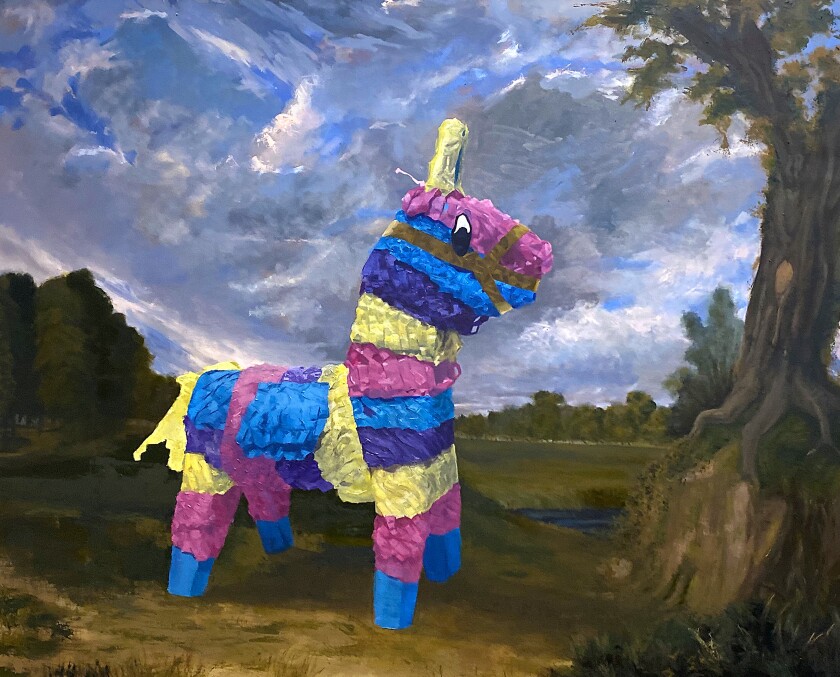
“All I know is that this is when I have to work extra hard,” he says. “Because that’s how this thing goes. It’s stagnant, then, out of nowhere, I’ve got three shows. And I need to be ready.”
He looked at “Agárrate Papá" and says: “That’s why I’m calling it that.” (Roughly translated, the phrase means something along the lines of “Hold on, partner!”)
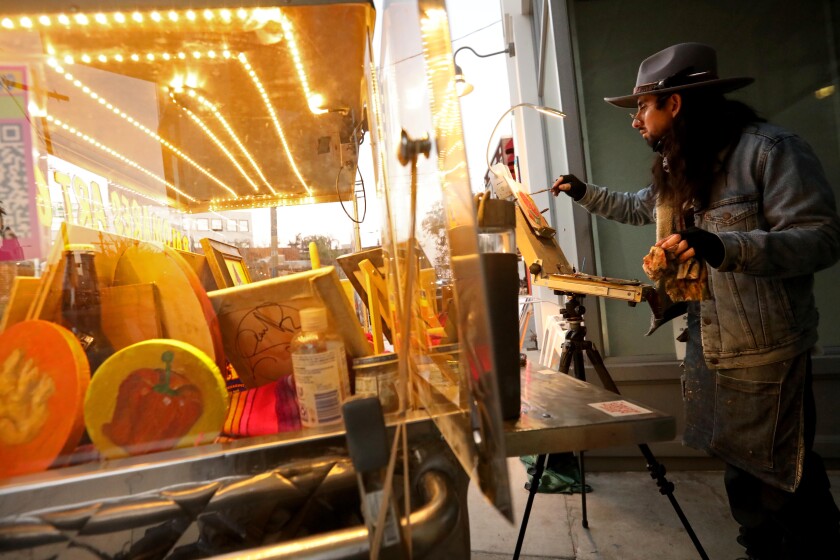
When the sun sets on the Arts District, Palomares’ playlist transitions to music that’s a bit more fast-paced, something like Tropa Magica’s “Disco Queen.” Then, the artist gets up to switch on the tiny lights that adorn his cart, as well as the portable lamps he uses to illuminate large prints.
Masked pedestrians and dog walkers come and go. A man shouts from a passing car: “Hey, bro, how much for the burro?”
"fruit" - Google News
March 08, 2021 at 11:00PM
https://ift.tt/3rue0Un
Fruit cart as art gallery? It's how Francisco Palomares paints - Los Angeles Times
"fruit" - Google News
https://ift.tt/2pWUrc9
https://ift.tt/3aVawBg
Bagikan Berita Ini














0 Response to "Fruit cart as art gallery? It's how Francisco Palomares paints - Los Angeles Times"
Post a Comment